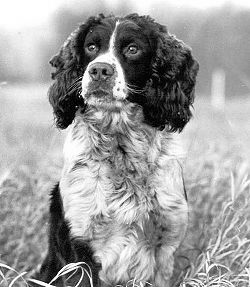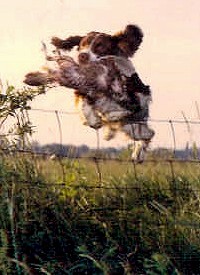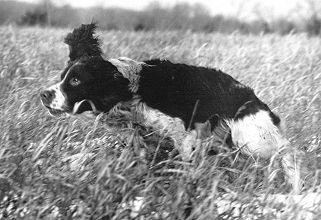 
Sometime during his early training he acquired his call name, "Fire". He was one of five puppies born in Wales at the Gwibernant Kennels owned and operated by the internationally renowned Keith Erlandson. A well-known and famous sire of his time, Hales Smut, was Fire’s father.
Fire was picked from the litter at the age of three months. His new owner, however, found him impossible to train and sent him to Mr. Hugh Clark in Ireland with instructions to train him or shoot him. Hugh later told Keith that “this was the finest dog he ever trained.” He probably was the inventor of Fire’s nickname because of his burning enthusiasm. Subsequently, Talbot Radcliffe, with his keen perception of spaniel talent, bought Fire.
In 1957, my first English springer spaniel was a 2-year-old female bred by Eudore Chevrier at his Avandale Kennels of Winnepeg, Canada. My interest was primarily in hunting until I discovered the competitive challenge of field trials. I then bred “Katie” to National Champion, Brackenbank Tangle. A male from this litter was my first entry into field trials in 1963. This led to meeting Jack Redeman and Ted Mertes, both of who were successful field trialers and already had imported some outstanding spaniels from Talbot Radcliffe.
They introduced me to Talbot, who sent me the 21-month-old Fire on Feb. 10, 1966. After his arrival, it soon became apparent that this dog was something special. His wide casts, great desire, drive and bird finding were exceptional. In addition, he easily adjusted to his new home and handler, and we quickly became a team.
Seven months later, he placed third in an Amateur All Age in Minnesota - his first trial. Some additional placements followed until he hit his stride in the fall of 1967. That autumn, Fire won an Amateur All Age on two consecutive weekends followed by his first National Amateur Championship two weeks later. Charles S. Goodall, author of the book, The New Complete English Springer Spaniel, judged Fire’s victory at the Ohio Valley English Spring Spaniel Club Trial.
After the trial, Goodall wrote about Fire in the Dec. 16, 1967 issue of The American Field, "(this) classy British 2-year-old had one of the most sensational third series that we have ever seen. What a spaniel! He handled long falls, was positive in both stationary and moving game and did it all with verve, great speed, drive and class.’’ Goodall was so impressed that the cover of the third edition of his book carries a full-page photograph of Fire in the act of flushing a pheasant.
The following year, the exact scenario occurred with Fire winning two consecutive Amateur All Age trials then capturing the 1968 National Amateur Championship two weeks later.
Fire went on to make his Open Field Trial Championship before his retirement.
John DeMott, who was an astute student of the game before he became Radcliffe’s trainer of the Saighton spaniels, recently wrote to me his thoughts when he first attended a training session at Idle R’s Farms before his tenure in England. “As soon as Jack cast Fire off, I could see this dog was different. The speed and intensity with which Fire hunted was breath taking. To me, it seemed the dog’s entire focus of every fiber of his body was in finding birds as quickly as possible, while responding instantly to any command given.’’
My memories of Fire are numerous. His highlights, vivid. His love and devotion remain cherished.
Fire was inducted into the Field Trial Hall of Fame on Jan. 5, 2002. His photographs and memorabilia on exhibit in the hall will attest to his memory for generations of champions.
|


